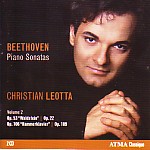The second two-disc installment of a projected Beethoven sonata cycle from Christian Leotta offers individualistic interpretations that alternately hit and miss, sometimes within the same work. The “Waldstein” first-movement exposition and recapitulation exude power and polish, yet the development comes off too sectionalized and rounded off for the arpeggiated sequences to generate the dramatic tension we expect. Leotta’s deliberation in the Rondo yields gorgeous, alluringly blurred sonorities at the outset as he observes Beethoven’s long pedal markings, yet the extensive scales and rotary figurations run in place, moving nowhere until the Presto coda: too little, too late.
By contrast, the Op. 22 sonata’s witty first movement exactly conveys the right rhythmic verve, followed by a broad yet well sustained Adagio. The longer than usual timings for the Minuetto and Rondo are not so much due to slow tempos as to how Leotta’s rounded phrasings, tenutos, and emphatic accents add up. Pedaling sparely, Leotta plays up the “Hammerklavier” first movement’s defiant grit at a steady, brisk tempo that comes close to Beethoven’s optimistic metronome marking. The Scherzo’s outer sections spring with caustic bite, yet his tempo adjustments soften the impact of the Trio’s climactic F major scales. Similar gearshifts sectionalize Leotta’s slowly unfolding Adagio. The pianist times the fourth movement introductory Largo’s petulant interruptions and canny silences to dramatic perfection, only to play things slightly safe in the fugue.
The improvisatory nature of Op. 109’s first movement can absorb Leotta’s metrical leeway. Although he never plays softly enough when required, Leotta does address the Prestissimo’s contrasts in articulation. While Leotta rigorously unifies the third-movement variations’ tempo relationships, his stern deliberation allows little of the music’s heartfelt lyricism to emerge, let alone the uplifting resonance others divine from the long chains of trills. Leotta’s capabilities as a colorist are best demonstrated in quieter music, while louder moments take on a harsh, metallic patina.
































